The Vertical Development of Fog in the Presence of Turbulent Mixing and Low Stratus Cloud Using Infra-Red Imagery During the SOFOG3D Campaign
Abstract
1. Introduction
2. Methods
2.1. Field Sites and Instrumentation
2.2. Case Study Selection
- Three cases where fog mixed with air above and deepened in situ (Section 3.1, Section 3.3.1 and Section 3.3.2). Of these three cases, there are two during which stratus then appeared to lower;
- One case where the fog mixed with the air above and stratus appeared to lower; the fog did not deepen until the stratus merged with it (Section 3.4);
- One case where fog mixed with both air and cloud above; fog then deepened due to an advective event (Section 3.2).
3. Results
3.1. Mixing Followed by In Situ Deepening of Fog (29 to 30 October 2019)
3.2. Mixing with Cloud Followed by Advective Deepening (30 to 31 March 2020)
3.3. Mixing Followed by In Situ Deepening of Fog and Apparent Stratus Lowering
3.3.1. 28 to 29 October 2019 Case
3.3.2. 5 to 6 December 2019 Case
3.4. Mixing Followed by Apparent Stratus Lowering (31 October to 1 November 2019)
3.5. Common Occurrences Across All Cases
4. Summary and Conclusions
Supplementary Materials
Author Contributions
Funding
Institutional Review Board Statement
Informed Consent Statement
Data Availability Statement
Acknowledgments
Conflicts of Interest
Appendix A
| Field Site | Measurement (Height) | Instrument | Uncertainty | Sampling/ Logging Frequency |
|---|---|---|---|---|
| Le Couye | Visibility (2, 23, and 48 m) | Campbell Scientific CS120 | 10% | 1 Hz/1 min |
| Le Couye | Temperature (1.2, 23 m, and 48 m) | PRTs: PT100 IEC60751 “A” | 0.1 °C | 1 Hz/1 min |
| Le Couye | Temperature (skin) | Heitronics KT19 II, KT-15D IRTs | 1 °C | 1 Hz/1 min |
| Le Couye | Longwave radiation (m) | Kipp and Zonen, CG4 | <4 Wm−2 | 1 Hz/1 min |
| Le Couye | Wind speed (2, 10, 23, 48 m) | Gill HS50 sonic anemometer | 2% | 10 Hz |
| Le Couye | Vertical velocity (2, 23, 48 m) | Gill HS50 | 20% | 10 Hz |
| Le Couye | Relative humidity (1.2 m) | Vaisala HMP155 | 1 to 2% | 1 Hz/1 min |
| Jachere and Charbonniere | Visibility (3 m) | Vaisala PWD 22/52 | 10% | 25 s/1 min |
| Jachere | Visibility (25 and 48 m) | Young Sentry 73,000 | 10% | 30 s/1 min |
| Jachere | Longwave radiation (1 m) | Kipp and Zonen, CNR4 | <4 Wm−2 | 10 s/1 min |
| FLIR A655s | |
|---|---|
| Accuracy (°C) | 2% |
| Sensitivity (°C) | 0.03 |
| Range (°C) | −40 to 150 |
| Image Resolution | 640 × 480 |
| Spectral Range (μm) | 7.5 to 14 |
| Acquisition Rate (Hz) | 50 |
| Angle of View (°) | 45 |
References
- Times of India. Available online: https://timesofindia.indiatimes.com/india/over-10000-lives-lost-in-fog-related-road-crashes/articleshow/67391588.cms (accessed on 1 December 2022).
- Ahmed, M.M.; Abdel-Aty, M.; Lee, J.; Yu, R. Real-time assessment of fog-related crashes using airport weather data: A feasibility analysis. Accid. Anal. Prev. 2014, 72, 309–317. [Google Scholar] [CrossRef]
- Gultepe, I.; Sharman, R.; Williams, P.D.; Zhou, B.; Ellrod, G.; Minnis, P.; Trier, S.; Griffin, S.; Yum, S.; Gharabaghi, B.; et al. A review of high impact weather for aviation meteorology. Pure Appl. Geophys. 2019, 176, 1869–1921. [Google Scholar] [CrossRef]
- Robinson, P.J. The influence of weather on flight operations at the Atlanta Hartsfield International Airport. Weather Forecast 1989, 4, 461–468. [Google Scholar] [CrossRef]
- Gultepe, I.; Tardif, R.; Michaelides, S.; Cermak, J.; Bott, A.; Bendix, J.; Müller, M.D.; Pagowski, M.; Hansen, B.; Ellrod, G.; et al. Fog research: A review of past achievements and future perspectives. Pure Appl. Geophys. 2007, 164, 1121–1159. [Google Scholar] [CrossRef]
- Kulkarni, R.; Jenamani, R.K.; Pithani, P.; Konwar, M.; Nigam, N.; Ghude, S.D. Loss to aviation economy due to winter fog in New Delhi during the winter of 2011–2016. Atmosphere 2019, 10, 198. [Google Scholar] [CrossRef]
- The Sunday Times. Available online: https://www.thetimes.co.uk/article/airport-dash-as-the-fog-lifts-jtx5j5hxrnz (accessed on 23 August 2024).
- Berry, Z.C.; Johnson, D.M.; Reinhardt. Vegetation-zonation patterns across a temperate mountain cloud forest ecotone are not explained by variation in hydraulic functioning or water relations. Tree Physiol. 2015, 35, 925–935. [Google Scholar] [CrossRef] [PubMed]
- Gehrig-Downie, C.; Marquardt, J.; Obregón, A.; Bendix, J.; Gradstein, S.R. Diversity and vertical distribution of filmy ferns as a tool for identifying the novel forest type “tropical lowland cloud forest”. Ecotropica 2012, 18, 35–44. [Google Scholar]
- Mitchell, D.; Henschel, J.R.; Hetem, R.S.; Wassenaar, T.D.; Strauss, W.M.; Hanrahan, S.A.; Seely, M.K. Fog and fauna of the Namib Desert: Past and future. Ecosphere 2020, 11, 1. [Google Scholar] [CrossRef]
- Gottlieb, T.R.; Eckardt, F.D.; Venter, Z.S.; Cramer, M.D. The contribution of fog to water and nutrient supply to Arthraerua leubnitziae in the central Namib Desert, Namibia. J. Arid Environ. 2019, 161, 35–46. [Google Scholar] [CrossRef]
- Tudor, M. Impact of horizontal diffusion, radiation and cloudiness parameterization schemes on fog forecasting in valleys. Meteorol. Atmos. Phys. 2010, 108, 57–70. [Google Scholar] [CrossRef]
- Pu, Z.; Chachere, C.N.; Hoch, S.W.; Pardyjak, E.; Gultepe, I. Numerical prediction of cold season fog events over complex terrain: The performance of the WRF model during MATERHORN-fog and early evaluation. Pure Appl. Geophys. 2016, 173, 3165–3186. [Google Scholar] [CrossRef]
- Charchere, C.N.; Pu, Z. Numerical simulations of an inversion fog event in the salt lake valley during the MATERHORN-fog field campaign. Pure Appl. Geophys. 2019, 176, 2139–2164. [Google Scholar] [CrossRef]
- Van der Velde, I.R.; Steeneveld, G.J.; Schreur, B.G.J.; Wichers; Holtslag, A.A.M. Modeling and forecasting the onset and duration of severe radiation fog under frost conditions. Mon. Weather Rev. 2010, 138, 4237–4253. [Google Scholar] [CrossRef]
- Steeneveld, G.J.; Ronda, R.J.; Holtslag, A.A.M. The challenge of forecasting the onset and development of radiation fog using mesoscale atmospheric models. Bound. Layer Meteorol. 2015, 154, 265–289. [Google Scholar] [CrossRef]
- Steeneveld, G.J.; Wokke, M.J.J.; Groot Zwaaftink, C.D.; Pijlman, S.; Heusinkveld, B.G.; Jacobs, A.F.G.; Holtslag, A.A.M. Observations of the radiation divergence in the surface layer and its implication for its parameterization in numerical weather prediction models. J. Geophys. Res. Atmos. 2010, 115, D6. [Google Scholar] [CrossRef]
- Smith, D.K.E.; Renfrew, I.A.; Dorling, S.R.; Price, J.D.; Boutle, I.A. Sub-km scale numerical weather prediction model simulations of radiation fog. Q. J. R. Meteorol. Soc. 2021, 147, 746–763. [Google Scholar] [CrossRef]
- Boutle, I.; Angevine, W.; Bao, J.-W.; Bergot, T.; Bhattacharya, R.; Bott, A.; Ducongé, L.; Forbes, R.; Goecke, T.; Grell, E.; et al. Demistify: A large-eddy simulation (LES) and single-column model (SCM) intercomparison of radiation fog. Atmos. Chem. Phys. 2022, 22, 319–333. [Google Scholar] [CrossRef]
- Dupont, J.C.; Haeffelin, M.; Protat, A.; Bouniol, D.; Boyouk, N.; Morille, Y. Stratus–fog formation and dissipation: A 6-day case study. Bound. Layer Meteorol. 2012, 143, 207–225. [Google Scholar] [CrossRef]
- Haeffelin, M.; Bergot, T.; Elias, T.; Tardif, R.; Carrer, D.; Chazette, P.; Colomb, M.; Drobinski, P.; Dupont, E.; Dupont, J.-C.; et al. PARISFOG: Shedding new light on fog physical processes. Bull. Am. Meteorol. Soc. 2010, 91, 767–783. [Google Scholar] [CrossRef]
- Fernando, H.J.; Gultepe, I.; Dorman, C.; Pardyjak, E.; Wang, Q.; Hoch, S.W.; Wauber, B. C-FOG: Life of coastal fog. Bull. Am. Meteorol. Soc. 2021, 102, E244–E272. [Google Scholar] [CrossRef]
- Singh, D.K.; Hoch, S.W.; Gultepe, I.; Pardyjak, E.R. A case study of the life cycle of a stratus-lowering coastal-fog event in Newfoundland, Canada. Q. J. R. Meteorol. Soc. 2024, 150, 641–662. [Google Scholar] [CrossRef]
- Fathalli, M.; Lac, C.; Burnet, F.; Vié, B. Formation of fog due to stratus lowering: An observational and modelling case study. Q. J. R. Meteorol. Soc. 2022, 148, 2299–2324. [Google Scholar] [CrossRef]
- Price, J.D. On the Formation and Development of Radiation Fog: An Observational Study. Bound. Layer Meteorol. 2019, 172, 167–197. [Google Scholar] [CrossRef]
- Price, J.; Stokkereit, K. The use of thermal infra-red imagery to elucidate the dynamics and processes occurring in fog. Atmosphere 2020, 11, 240. [Google Scholar] [CrossRef]
- Bergot, T. Large-eddy simulation study of the dissipation of radiation fog. Q. J. R. Meteorol. Soc. 2016, 142, 1029–1040. [Google Scholar] [CrossRef]
- Cuxart, J.; Jiménez, M.A. Deep radiation fog in a wide closed valley: Study by numerical modeling and remote sensing. Pure Appl. Geophys. 2012, 169, 911–926. [Google Scholar] [CrossRef]
- Burnet, F.; Lac, C.; Martinet, P.; Fourrié, N.; Haeffelin, M.; Delanoë, J.; Price, J.; Barrau, S.; Canut, G.; Cayez, G.; et al. The SOuth west FOGs 3D experiment for processes study (SOFOG3D) project. In Proceedings of the EGU General Assembly Conference, Vienna, Austria, 3–8 May 2020; p. 17836. [Google Scholar]
- Thornton, J.; Price, J.D.; Burnet, F.; Lac, C. Contrasting the evolution of radiation fog over a heterogeneous region in southwest France during the SOFOG3D campaign. Q. J. R. Meteorol. Soc. 2023, 149, 3323–3341. [Google Scholar] [CrossRef]
- Durran, D.R.; Klemp, J.B. On the effects of moisture on the Brunt–Väisälä frequency. J. Atmos. Sci. 1982, 39, 2152–2158. [Google Scholar] [CrossRef]
- Klaić, Z.B.; Belusić, D.; Grubisić, V.; Gabela, L.; Ćoso, L. Structure of mesoscale flow over the northern Adriatic during the MAP IOP 15 experiment—The case of a strong bora. Geophysics 2003, 20, 1. [Google Scholar]
- Rehman, S. Tower distortion and scatter factors of co-located wind speed sensors and turbulence intensity behaviour. Renew. Sustain. Energy Rev. 2014, 34, 20–29. [Google Scholar] [CrossRef]
- Delanoë, J.; Protat, A.; Vinson, J.-P.; Brett, W.; Caudoux, C.; Bertrand, F.; Parent du Chatelet, J.; Hallali, R.; Barthes, L.; Haeffelin, M.; et al. BASTA: A 95-GHz FMCW Doppler radar for cloud and fog studies. J. Atmos. Ocean. Technol. 2016, 33, 1023–1038. [Google Scholar] [CrossRef]




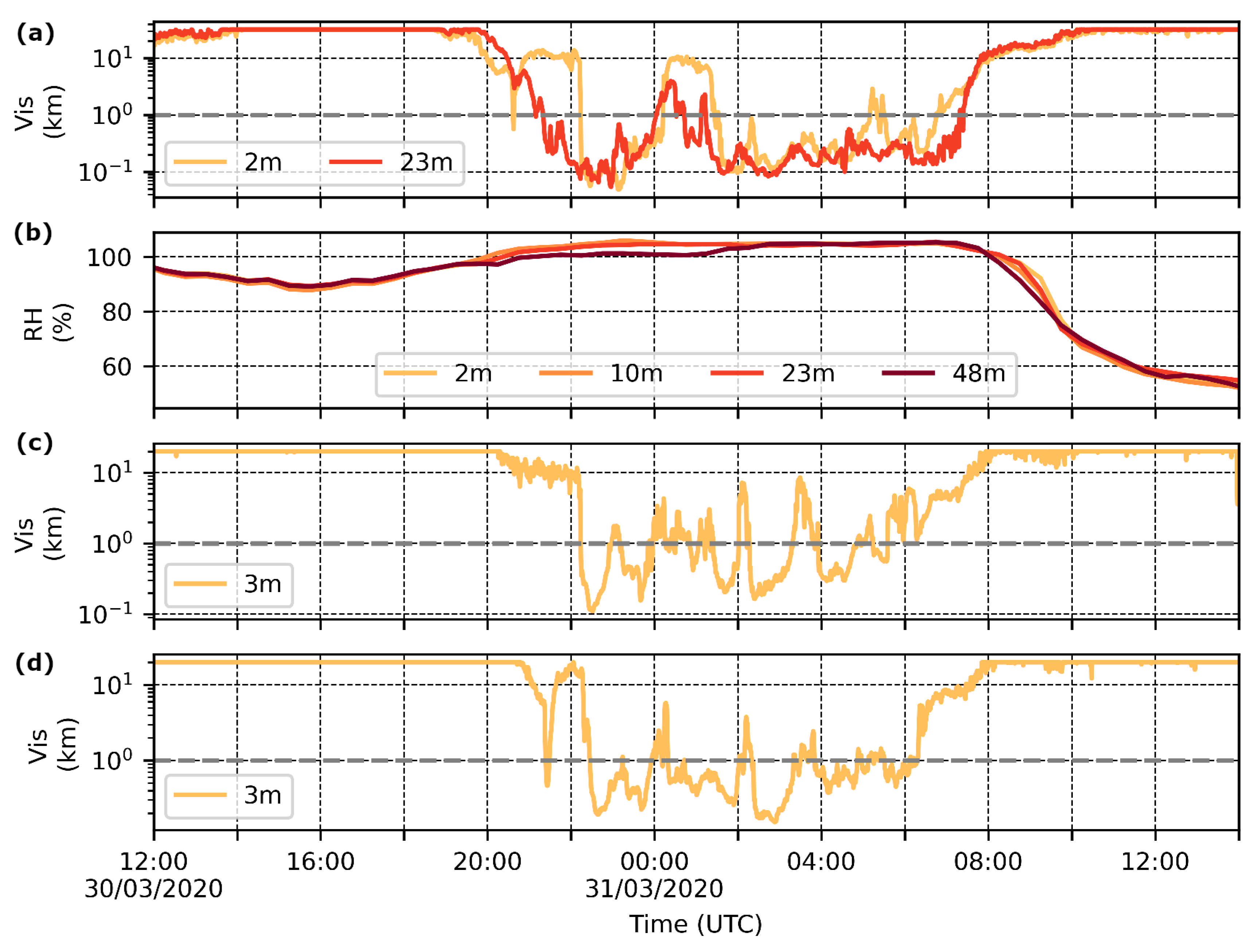
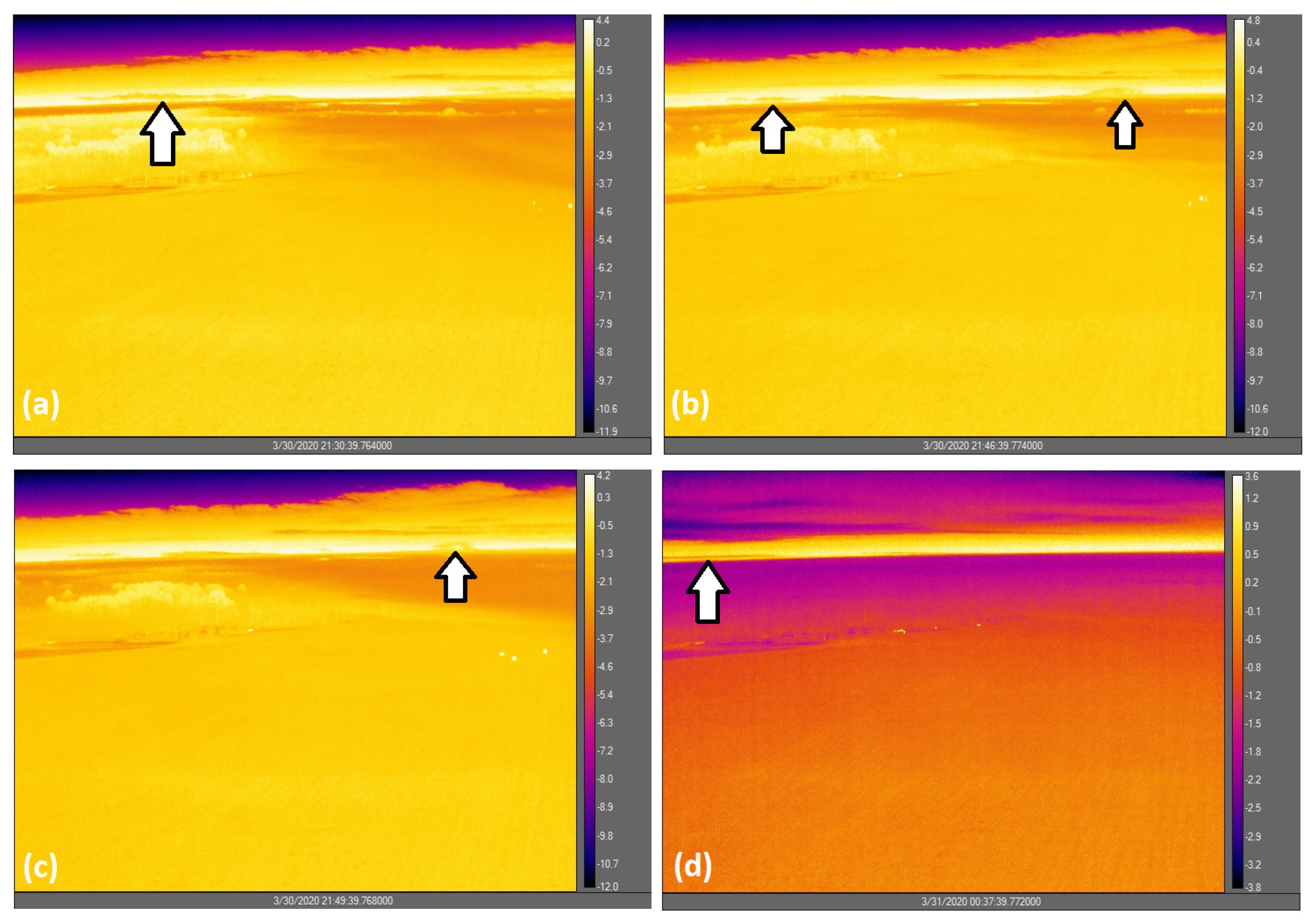

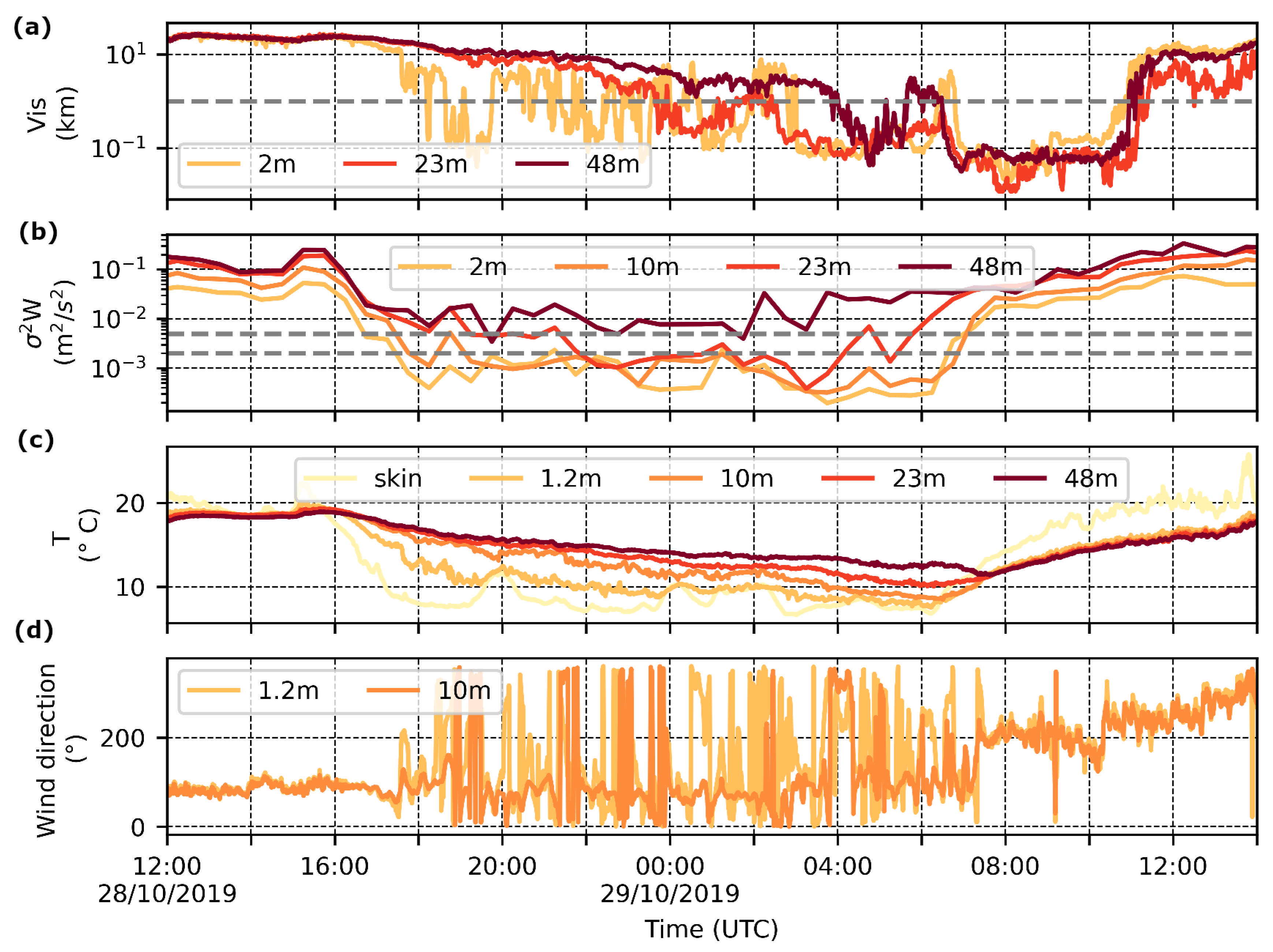
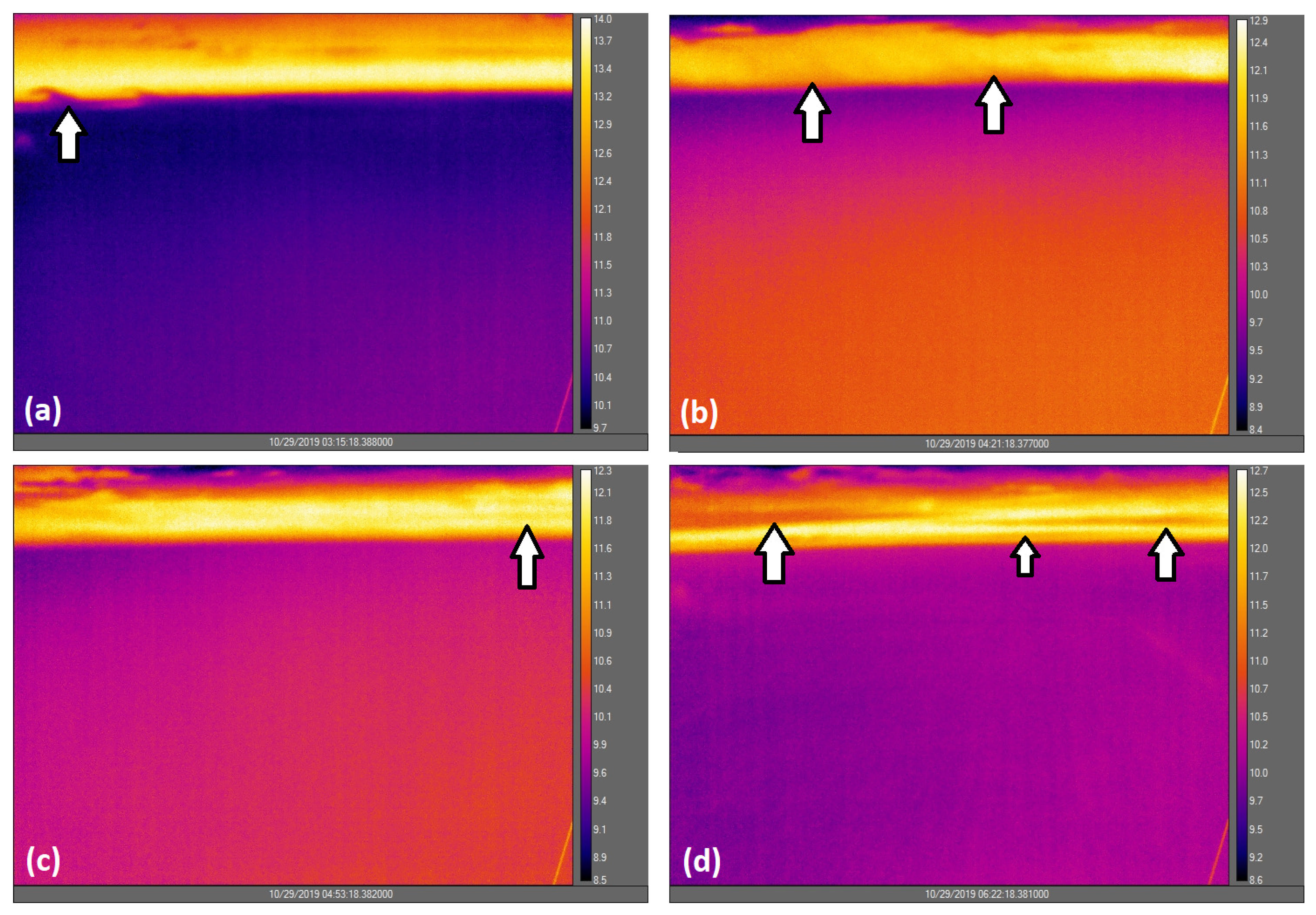


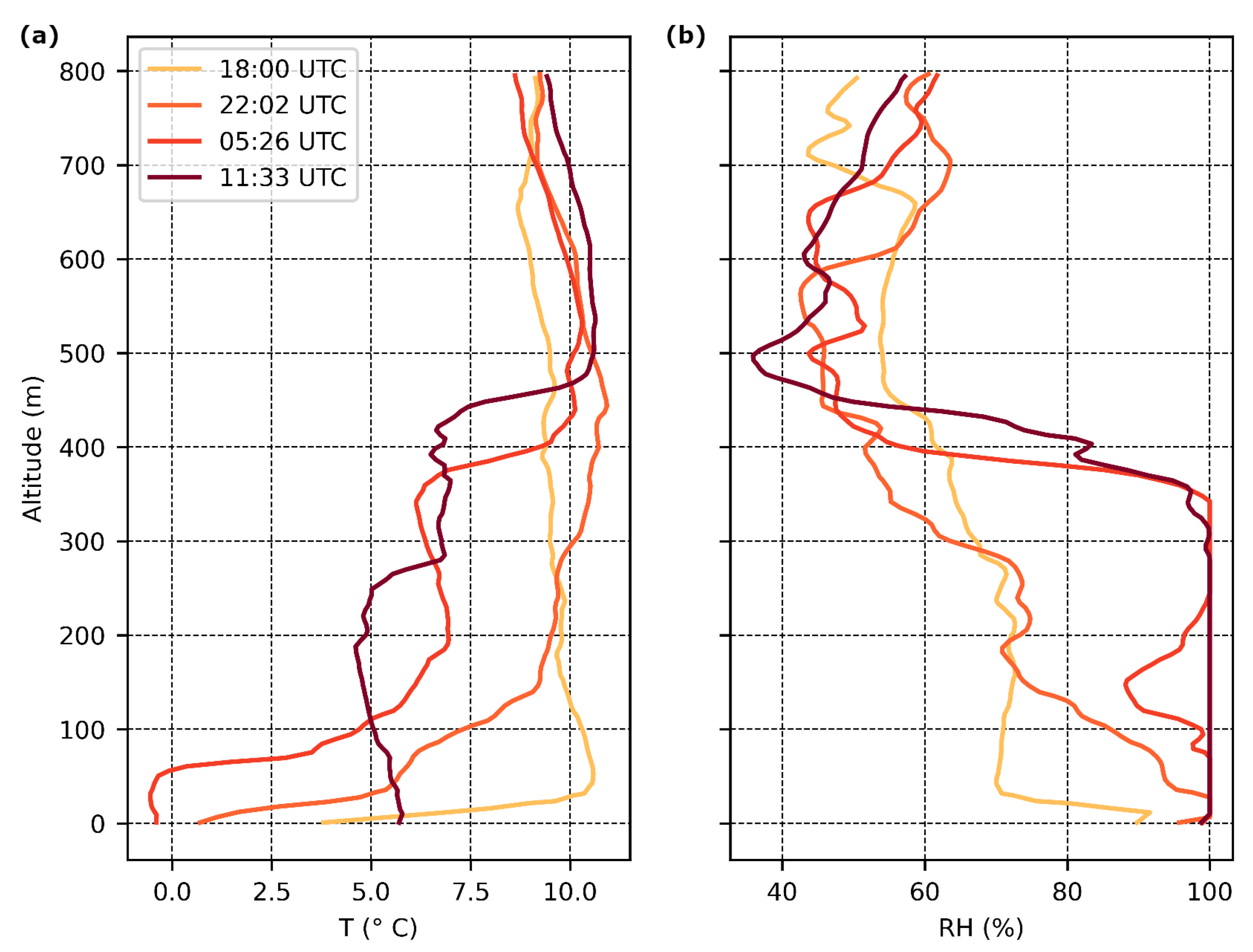
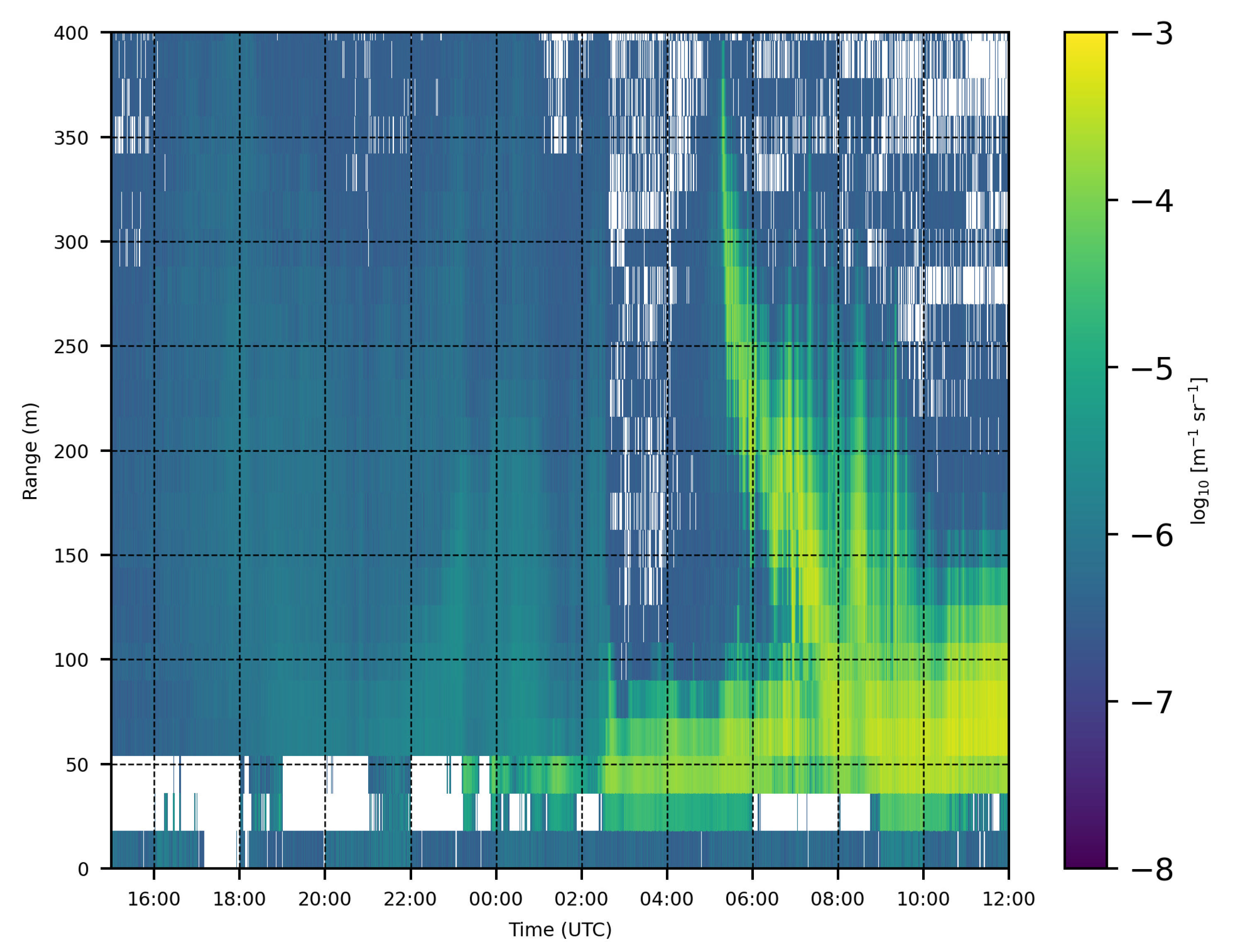
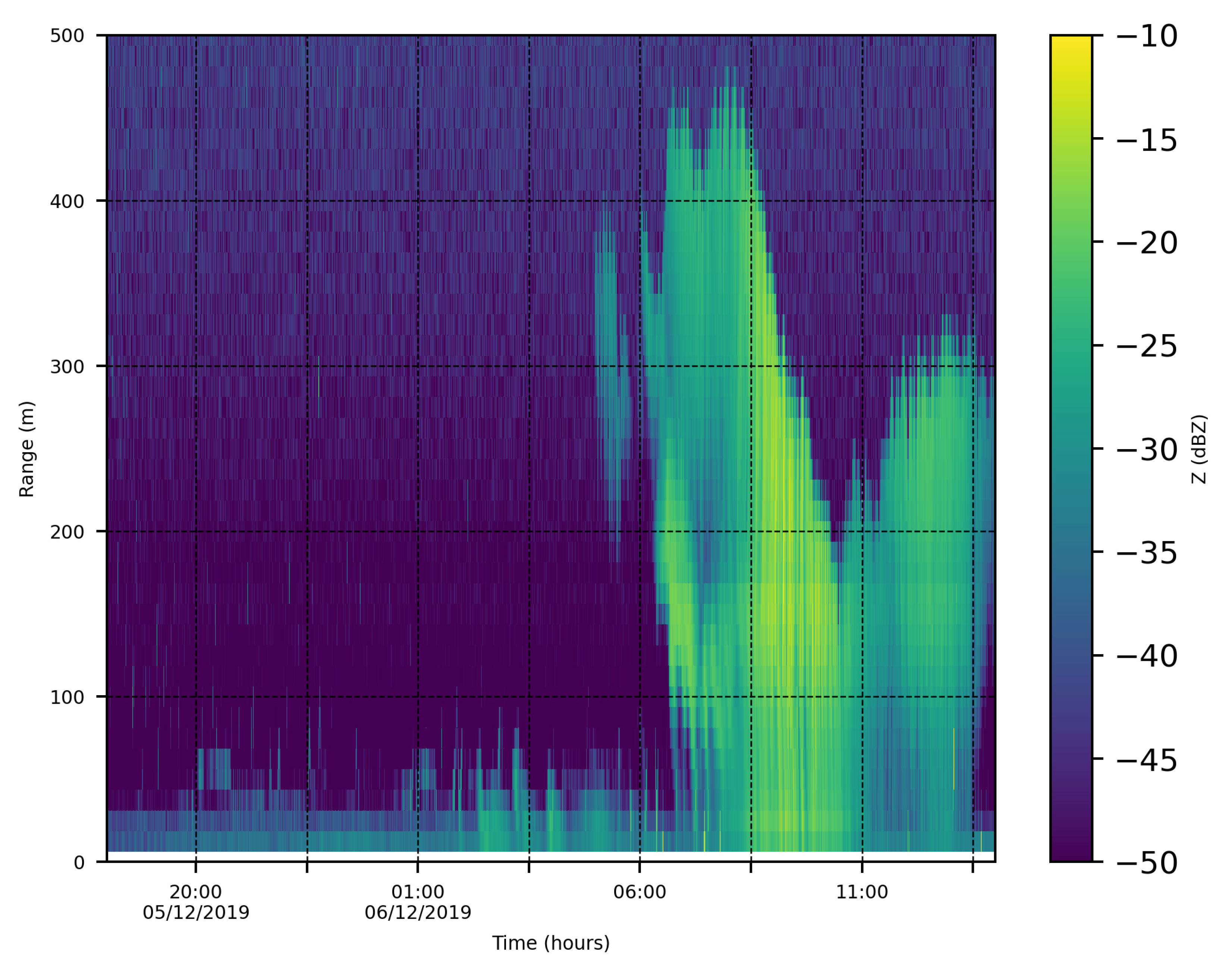
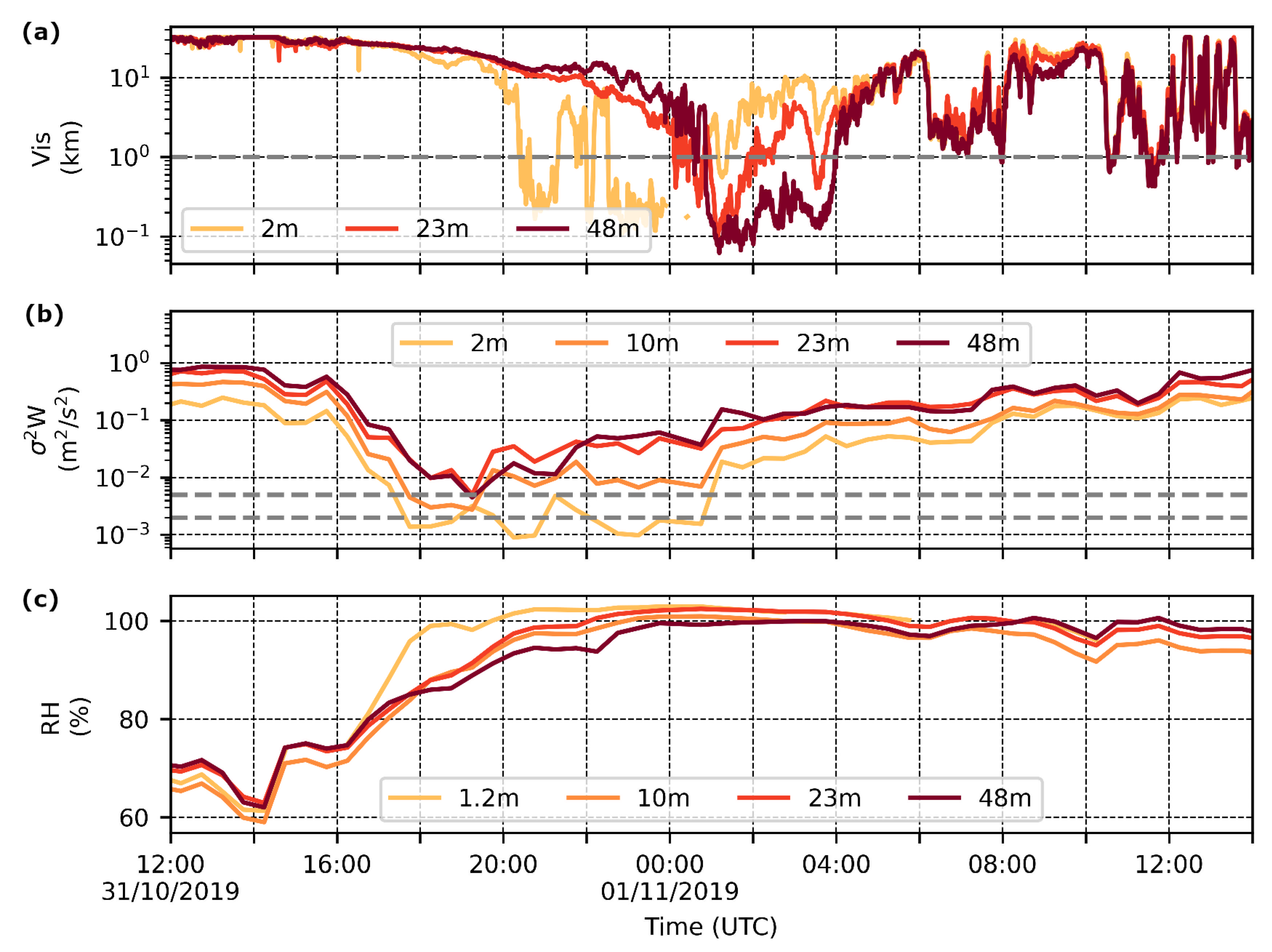
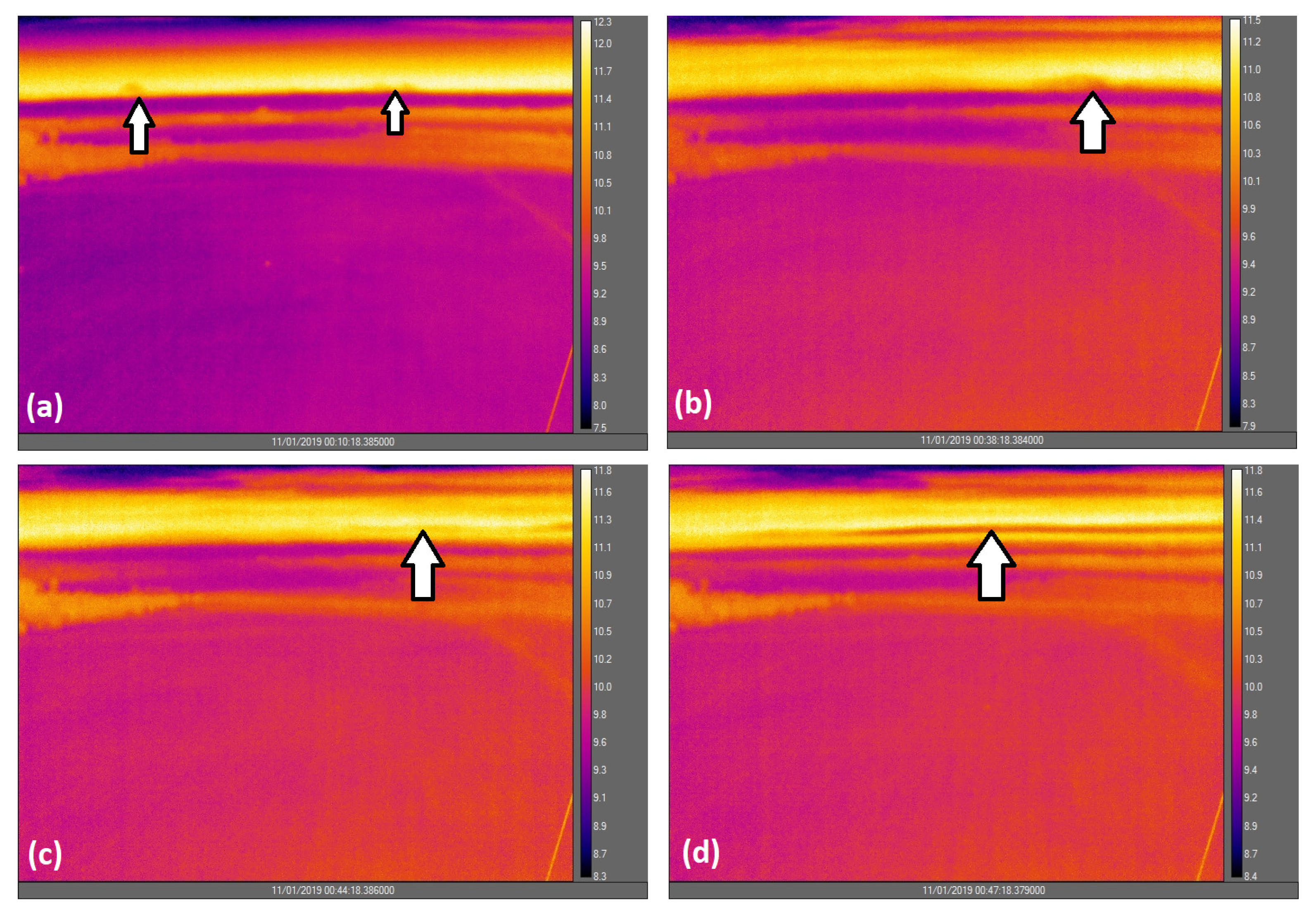
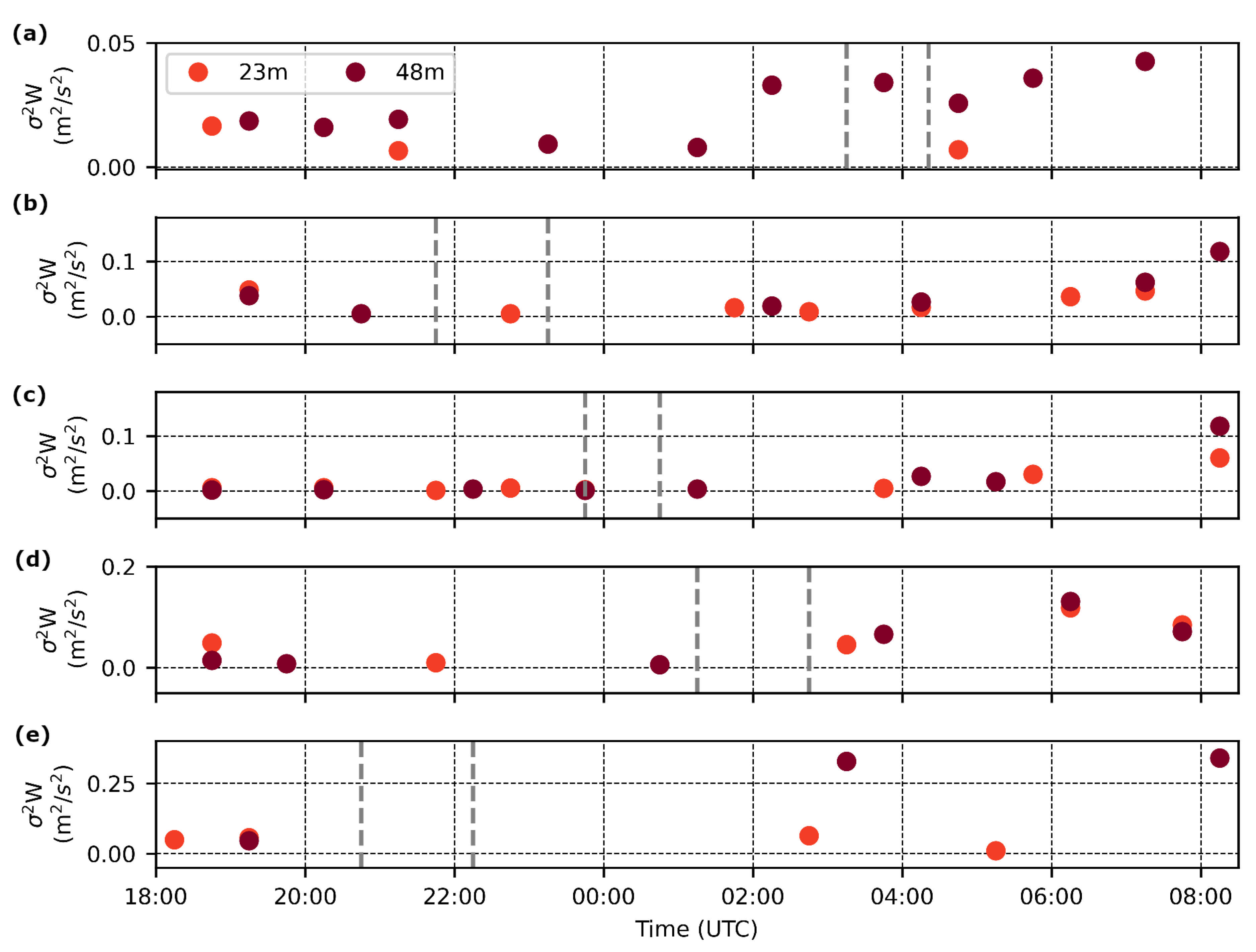
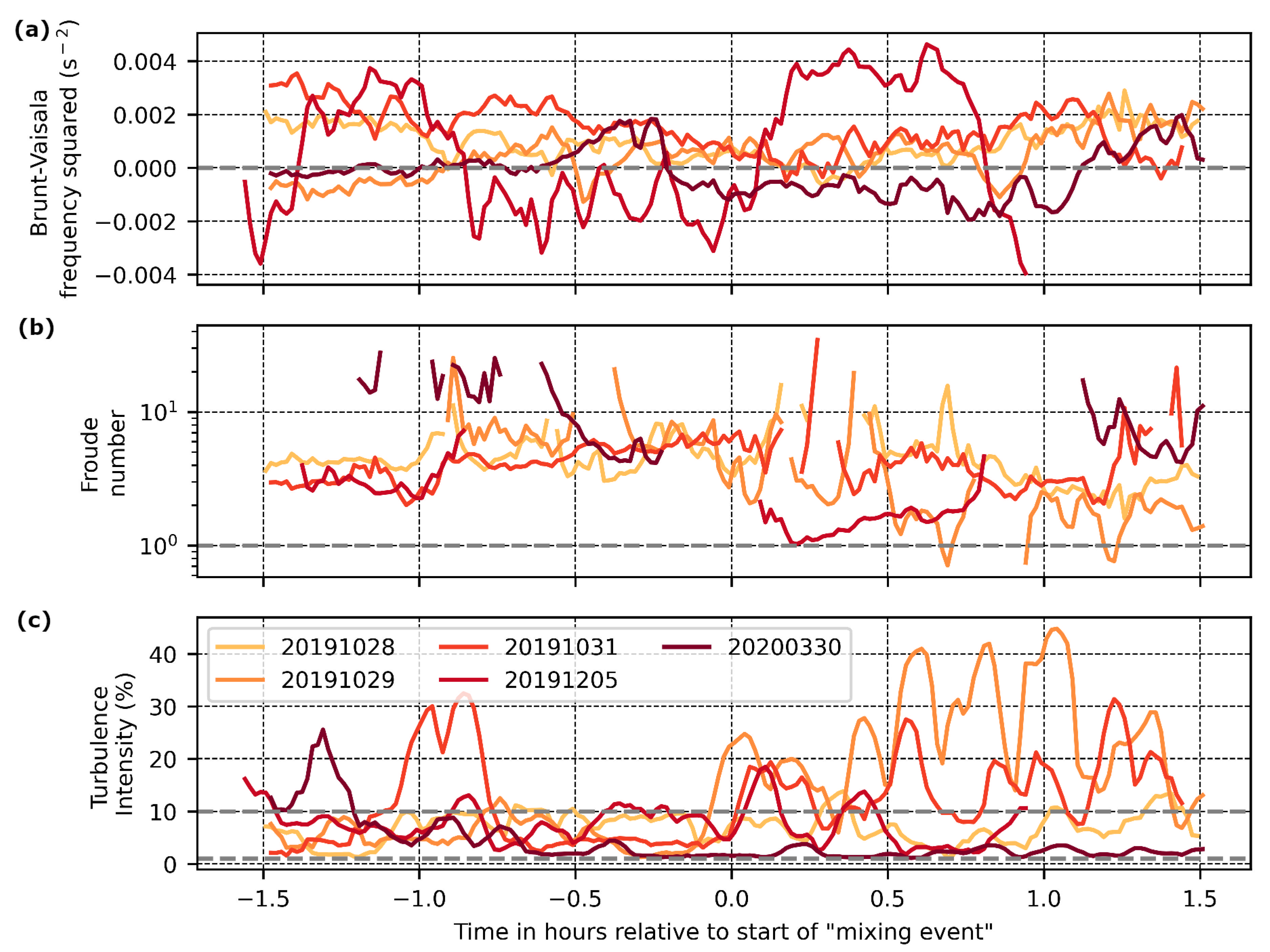
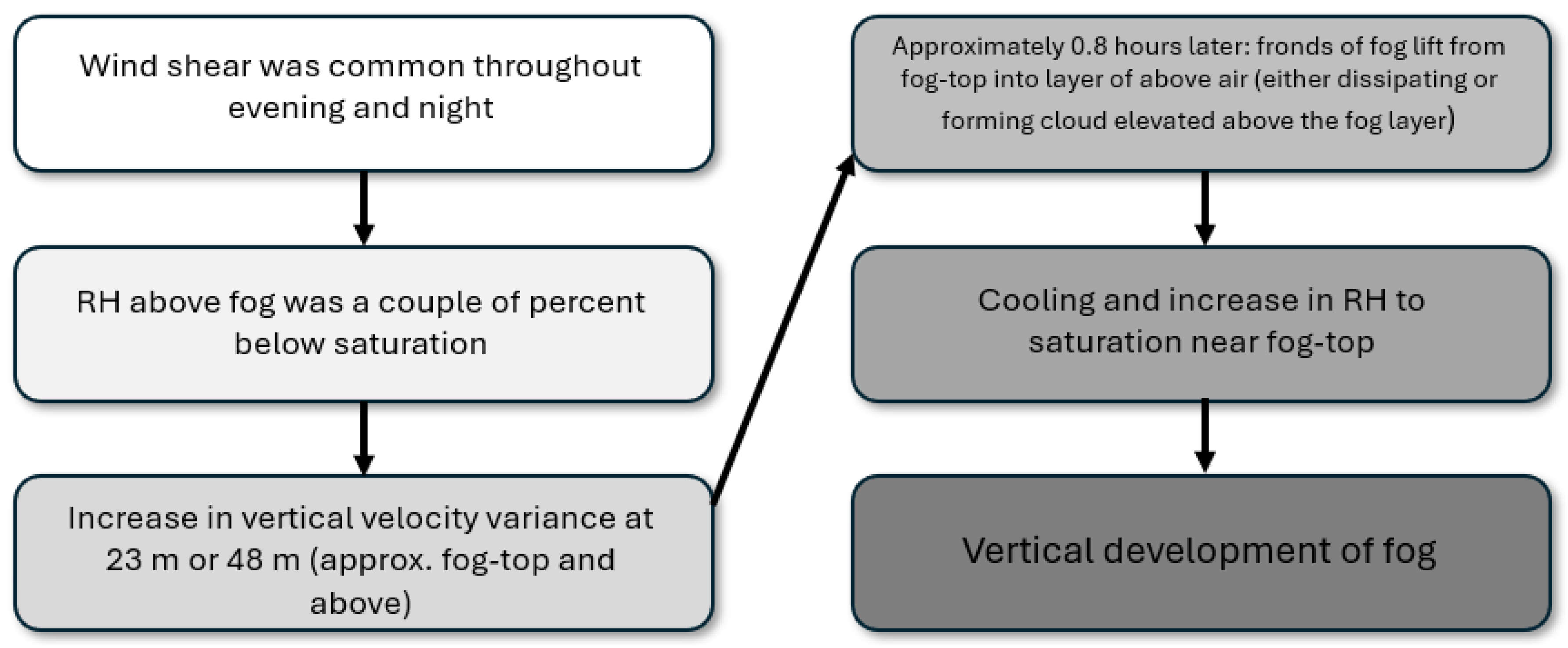
| Dates of Fog Event | Fog Development | Approximate Mixing Period(s) |
|---|---|---|
| 28–29 October 2019 | Shallow radiation fog which deepened in situ after the mixing was observed; stratus cloud later appeared to lower and merge with fog | 03:00 to 04:00 UTC (29th) |
| 29–30 October 2019 | Shallow radiation fog which deepened in situ after the mixing was observed | 22:00 to 23:00 UTC (29th) |
| 31 October to 1 November 2019 | Shallow radiation fog initially; after the mixing was observed, stratus cloud appeared to lower, which caused some dissipation of the radiation fog | 23:50 to 00:45 UTC (30th to the 1st) |
| 5–6 December 2019 | Shallow radiation fog which deepened in situ after the mixing was observed; stratus cloud later appeared to lower, which caused some dissipation of the radiation fog | 01:20 to 01:40 UTC and 02:37 UTC (6th) |
| 30–31 March 2020 | Shallow radiation fog advected to the site, and mixing was observed during this process; fog temporarily dissipated but then reformed and developed vertically | 21:00 to 22:00 UTC (30th) |
| Dates of Fog Event | Time Between the Start of the “Mixing Event” and the Preceding Increase in Vertical Velocity Variance (W) |
|---|---|
| 28–29 October 2019 | 1 h (W increase at 48 m) |
| 29–30 October 2019 | 1 h (W increase at 48 m) |
| 31 October to 1 November 2019 | 0 h (W increase at 48 m); 1 h (W increase at 48 m) |
| 5–6 December 2019 | 0.5 h (W increase at 48 m) |
| 30–31 March 2020 | 1.5 h (W increase at 23 m and 48 m) |
Disclaimer/Publisher’s Note: The statements, opinions and data contained in all publications are solely those of the individual author(s) and contributor(s) and not of MDPI and/or the editor(s). MDPI and/or the editor(s) disclaim responsibility for any injury to people or property resulting from any ideas, methods, instructions or products referred to in the content. |
© 2025 by the authors. Licensee MDPI, Basel, Switzerland. This article is an open access article distributed under the terms and conditions of the Creative Commons Attribution (CC BY) license (https://creativecommons.org/licenses/by/4.0/).
Share and Cite
Thornton, J.; Price, J.; Burnet, F.; Delanoë, J. The Vertical Development of Fog in the Presence of Turbulent Mixing and Low Stratus Cloud Using Infra-Red Imagery During the SOFOG3D Campaign. Atmosphere 2025, 16, 1338. https://doi.org/10.3390/atmos16121338
Thornton J, Price J, Burnet F, Delanoë J. The Vertical Development of Fog in the Presence of Turbulent Mixing and Low Stratus Cloud Using Infra-Red Imagery During the SOFOG3D Campaign. Atmosphere. 2025; 16(12):1338. https://doi.org/10.3390/atmos16121338
Chicago/Turabian StyleThornton, Jenna, Jeremy Price, Frederic Burnet, and Julien Delanoë. 2025. "The Vertical Development of Fog in the Presence of Turbulent Mixing and Low Stratus Cloud Using Infra-Red Imagery During the SOFOG3D Campaign" Atmosphere 16, no. 12: 1338. https://doi.org/10.3390/atmos16121338
APA StyleThornton, J., Price, J., Burnet, F., & Delanoë, J. (2025). The Vertical Development of Fog in the Presence of Turbulent Mixing and Low Stratus Cloud Using Infra-Red Imagery During the SOFOG3D Campaign. Atmosphere, 16(12), 1338. https://doi.org/10.3390/atmos16121338






